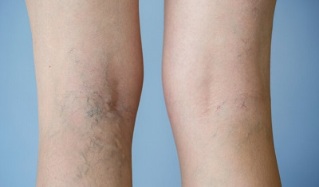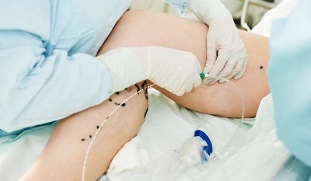
Signs of varicose veins of the legs in women are common - this pathology is detected in almost every third woman. The disease, accompanied by dilation of the lumen and thinning of the walls of the venous vessels, not only leads to the appearance of cosmetic defects, but also accompanied by pain and malnutrition in the tissues in the lower legs. As a result, if left untreated, a woman may develop trophic ulcers on her legs, resulting in more serious complications. That is why the start of varicose vein treatment should always be timely.
Signs of varicose veins in the legs in women are not always visible at an early stage - sometimes the disease lasts a long time.
Initial reasons and signs
The veins in the legs are affected by varicose veins under the influence of the following factors:
- overweight;
- descent;
- inactive lifestyle;
- has long been in a static position;
- pregnancy;
- give birth to a child;
- take birth control pills;
- increased abdominal pressure with frequent or prolonged cough, sneezing, or constipation; excessive
- during physical exercise or exercise;
- foot injury;
- pelvic pathology;
- excessive use of tanning or thermal treatment;
- wearing uncomfortable shoes;
- the habit of sitting cross-legged;
- alcohol abuse;
- old age.
Due to increased pressure on the veins and stagnation of blood, the blood vessels become swollen, the blood flow in them changes direction and the flow rate, as the vessel wall changes tone, and the valve stops functioning normally. As a result, vein changes cause the development of vascular spheres in hemodynamics and other functions of the venous vessels.
In the early stages of varicose veins, blood flow can still be compensated in a conservative way - wearing compression underwear, gymnastics and the use of venotonics. However, as the disease progresses, changes in the structure of the veins become irreversible and can only be removed surgically.
Varicose vein symptoms can disrupt the normal rhythm of life.
The following manifestations may be the first sign of varicose veins:

- weight on the legs;
- appearance of telangiectasias - spider veins and nets of different colors (bluish, red, black);
- satiety during prolonged stay in motion (sitting, standing);
- seizures at night;
- Relieves symptoms after walking or resting in a horizontal position.
Often, the first manifestation of this common disease is due to fatigue, and a visit to the doctor may be delayed until serious consequences of the disease appear. As the expansion of the venous wall progresses, the symptoms become more pronounced, and then a new one is added to the above manifestations.
Symptoms
Enlargement of varicose veins at a later stage is indicated by the following symptoms:
- rapid leg fatigue;
- sick;
- feels full of liquid;
- swelling of soft tissues after exercise;
- penetrates and protrudes large veins over skin;
- itchy skin;
- bruises due to rupture of large vessels;
- peeling skin;
- hair loss;
- trophic ulcer.
Against the background of varicose veins in women, blood clots - thrombi - can form in the venous lumen. As they migrate through the bloodstream, the consequences of various severities develop: thrombosis, flembothrombosis, the development of cardiovascular disease, the opening and swelling of ulcers, the entry of blood clots into the heart or lungs.
Diagnostics and treatment
To confirm the diagnosis, a woman should contact a vascular surgeon and undergo an examination. The diagnostic plan includes examination with instrumental study:
- Doppler foot ultrasound;
- duplex angioscanning;
- rheovasografi;
- X-ray and radionuclide methods.
Tactics for treating varicose veins of the legs are determined by the stage of the disease. Conservative methods can be used from the beginning:
- wear compression socks or wrapped in an elastic bandage;
- adequate physical activity;
- wear comfortable shoes;
- physiotherapy training;
- removal of static load on legs;
- venotonic applications.
The duration of conservative therapy is individual and depends on the rate of disease progression and adherence to physician recommendations. This can be supplemented with a special diet, which implies the inclusion of food in the diet that helps strengthen the walls of blood vessels.
The probability of varicose veins will subside under the onslaught of conservative treatment determined by each clinical case. In many ways, the success of therapy depends on the timeliness of the visit to the doctor.
Also, this therapy is recommended at the preparatory stage for surgical treatment or for patients contraindicated for invasive intervention.
Sometimes prevention of the development of varicose veins can occur in performing minimally invasive interventions. That only applies to strict indications, which are determined during patient examination.
Advanced treatment of varicose veins usually involves surgical operation - minimal or classical invasive.

If possible, a woman is recommended radical treatment of varicose veins in the legs:
- compression sclerotherapy;
- laser freezing;
- photocoagulation;
- radio frequency freezing.
If the effect of this minimally invasive technique is insufficient, then for more radical surgical treatment, classical surgery is performed:
- miniflebectomy;
- phlebectomy;
- Trendelenburg method (with complications by thrombosis and infection).
Sometimes classic surgical techniques are augmented with minimal use of invasive techniques. This combination can reduce surgical trauma and shorten the postoperative recovery period.
Varicose veins in the lower extremities can be successfully treated, especially in the early stages. That is why the first signs of this disease should always be a reason to visit a vascular surgeon. Varicose veins can occur at different ages, and observations show that women are more likely to suffer from the disease. The signs of varicose veins on the legs are the same as in men.




































